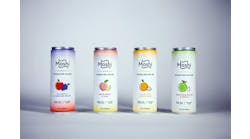The Food Guide Pyramid is now 12 pyramids, each having vertical rather than horizontal stripes plus a little man running up their sides. Agriculture Secretary Mike Johanns on April 19 unveiled MyPyramid, a new symbol and interactive food guidance system that replaces the Food Guide Pyramid introduced in 1992. "Steps to a Healthier You," MyPyramid's central message, embodies the new emphasis on exercise and acknowledges in its 12 variations the need for a more individualized approach to improving diet and lifestyle.MyPyramid incorporates recommendations from the 2005 Dietary Guidelines for Americans, which was released by the Dept. of Agriculture (USDA) and Dept. of Health and Human Services in January. The guidelines as well as the new pyramid boost the importance of fruits and vegetables, whole grains and even healthful fats (such as nuts and olive oil), while limiting added sugar, saturated fat and trans fatty acids.In MyPyramids vertical bands, orange stands for grains (6 oz., about three servings, is recommended every day), green for vegetables (2.5 cups per day), red for fruits (2 cups per day), blue for milk products (3 cups per day), purple for meats and beans (5.5 oz. per day) and only a sliver of yellow is allowed for fats, added sugars and salt.The logic of the old pyramid lay in its wide base (which suggested plenty of grains) and narrow tip (which meant limited fats and sweets). In between were narrowing rows of vegetables, fruits and dairy products. Now there are 12 personalized pyramids reflecting the January guidelines divergence into 12 different caloric intakes from 1,000 calories for sedentary two-year-olds to 2,000 calories for a rough median to 3,200 calories for athletic teenage boys. USDA is placing a big bet on the Internet and the interactivity of the new pyramid. The new food guidance system uses interactive technology found on www.mypyramid.gov. The web site asks individuals to key in their age, gender and physical activity level so they can get a more personalized recommendation on their daily calorie level based on the 2005 Dietary Guidelines for Americans. It also allows visitors to find general food guidance and suggestions for making smart choices from each food group."MyPyramid is about the ability of Americans to personalize their approach when choosing a healthier lifestyle that balances nutrition and exercise," said Johanns. "Many Americans can dramatically improve their overall health by making modest improvements to their diets and by incorporating regular physical activity into their daily lives."Dont forget the guy running up the side of the edifice. Hes the reminder of one of the most talked-about components of the January guidelines: the recommendation that nearly all people should get 30, 60, maybe even 90 minutes of exercise each day. While the meaning of the triangular bands is not intuitive, USDA says the wide base and narrow top for every food group means we should eat more of those foods with low fats and added caloric sweeteners and less of those foods in that category with heavier amounts of those bad things.Some of the features of www.mypyramid.gov:
- MyPyramid Plan provides a quick estimate of what and how much food you should eat from the different food groups by entering your age, gender and activity level.
- MyPyramid Tracker provides more detailed information on your diet quality and physical activity status by comparing a day's worth of foods eaten with current nutrition guidance. Relevant nutrition and physical activity messages are tailored to your desire to maintain your current weight or to lose weight.
- Inside MyPyramid provides in-depth information for every food group, including recommended daily amounts in commonly used measures, like cups and ounces, with examples and everyday tips. The section also includes recommendations for choosing healthy oils, discretionary calories and physical activity.
- Start Today provides tips and resources that include downloadable suggestions on all the food groups and physical activity, and a worksheet to track what you are eating.

